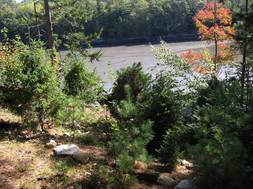
While
many municipalities require sufficient replanting of vegetation when a
permitted project is proposed within the shoreland zone buffer area, such as a
shoreline stabilization project, we continue to find that some municipalities
are not requiring adequate replanting.
Replanting of vegetation is necessary for a project located in the
shoreland zone when the project requires removal of more vegetation than would
otherwise be allowed within the municipal ordinance. This permitted excessive removal of
vegetation is not considered to be a violation unless replanting of vegetation
is not completed within a reasonable time period (e.g. same growing season, or
spring growing season for winter projects).
Examples
of such projects can include shoreline stabilization, removal or reconstruction
of a non-conforming structure, construction of a functionally water-dependent
structure at or near the shoreline (e.g. a pier), and the removal of hazard and
storm-damaged trees.
Not
all projects located within the shoreland zone are permitted to remove
vegetation in excess of the removal standards. For instance, the construction
of a new house that meets the shoreline setback requirement on an undeveloped
lot may not cause the removal of vegetation within the setback/buffer
area.
To
help improve consistency from one municipality to another, below is a summary
of the longstanding general revegetation standards that should be required by
all municipalities. Municipalities
should be approving a revegetation plan as part of the application and that
complies with these standards at the same time it approves the proposed
project. Here are the general standards:
Trees: when trees are
removed in excess of the ordinance standards in order to conduct a permitted
project, trees must be replanted.
Replanted trees must be similar native species as were removed or native
to the immediate area of shoreline.
Hardwood tree species must be a minimum of 6 feet in height and softwood
species must be a minimum of 3 feet in height.
The planting density must be no less than one tree per 80 square feet of
affected area, with limited exception.
An exception to the density requirement would apply when very few
existing trees were either present prior to commencement of the project or very
few were removed for a project, in which case the number of trees to be
replanted would be based on a minimum 1:1 replanting ratio (1 tree planted for every 1 tree
removed).
Replanted trees must be randomly
distributed within the same general location as where they were removed, or if
not possible then as close to the removal location as practical. In the case of shoreline stabilization
projects, trees are not required to be planted to replace removed trees that
are (marginally) alive, but that have fallen to a horizontal or nearly
horizontal position due to natural (slope failure) conditions. Removed dead trees do not have to be
replaced.
Shrubs: when shrubs are removed in excess of the
ordinance standards in order to conduct a permitted project, shrubs must also
be replanted. Replanted shrubs must be
similar native species as removed or if not readily available at commercial
nurseries then other suitable native species that grow to a similar size may be
planted.
Shrub species must be planted at a
density of one plant spaced 3 feet on center, and be planted throughout the
affected area. Shrubs must also be
planted in accordance with these requirements in areas where shrubs were not
removed, but would otherwise result in a non-vegetated area unless the area had
been a legally existing maintained grass lawn- in which case grass lawn could
be re-established without shrub planting being necessary.
Other: Herbaceous vegetation (grasses, sedges,
wildflowers, etc.) and other ground cover, including the organic duff layer,
must be re-established in areas where it was removed except for areas treated
with riprap or other similar structure.
Such vegetation and ground cover must be re-established around any tree
and shrub planting as described above.
Several examples include planting a conservation seed mix, low-bush
blueberry sod, and spreading a 4”- 6” thick layer of natural leaf or pine needle
litter or a commercially available product that functions similarly throughout
the affected area.
Every
site is unique and doesn’t necessarily fit into the same mold. Please don’t
hesitate to contact the Department’s Shoreland Zoning Unit staff for assistance
if you have questions about replanting requirements at a particular site.
|